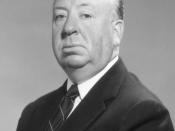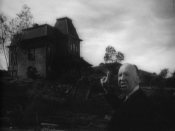Alfred Hitchcock's Psycho has been commended for forming the basis for all horror films that followed its 1960 release. It terrified audiences in 1960, and surprisingly, still holds up very well today. The characters in Psycho seem to be connected by a sense of spit personality and the presence of conscience. It is these character parallels that Hitchcock uses to convey his theme of "good vs. evil" in Psycho.
It is with Marion's character that Hitchcock first introduces the notion of a split personality to the audience. Throughout the first part of the film, Marion's reflection is often noted in several mirrors and windows. In the car dealership Marion enters the bathroom in order to have privacy while counting her money. "Hitchcock, however, uses upper-camera angles and the convenient placing of a mirror to convey the sense of a lingering conscious mind that makes privacy impossible." (Filmguide 43)
The split personality theme reaches the height of its foreshadowing power as Marion battles both sides of her conscience while driving on an ominous and seemingly endless road toward the Bates Motel.
"Marion wrestles with the voices of those that her crime and disappearance has affected while the audience is compelled to recognize as to why it can so easily identify with Marion despite her wrongful actions." (...At Work 85) As her journey comes to an end, the suspicion that Marion feels while at the motel is also felt by the audience. As Marion shudders while hearing Norman's mother yell at him, the audience's suspicions are heightened. Hitchcock has, at this point, made Marion a vital link between the audience and the plot.
The initial interaction between Marion and Norman Bates subtly and slowly sway the audience's sympathy from Marion to Norman. "Hitchcock compels the audience to identify with the quiet and...


